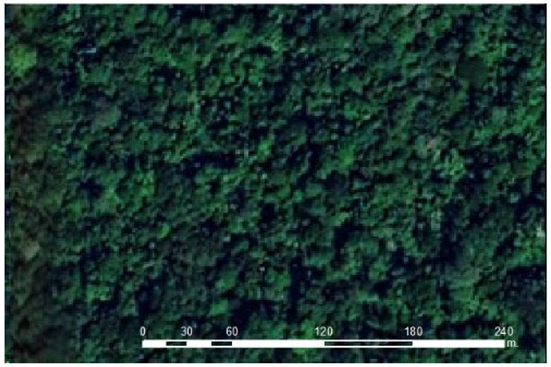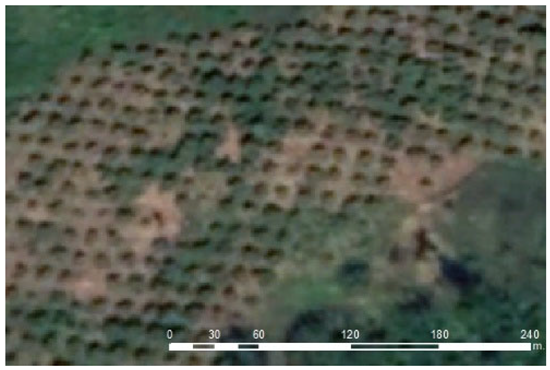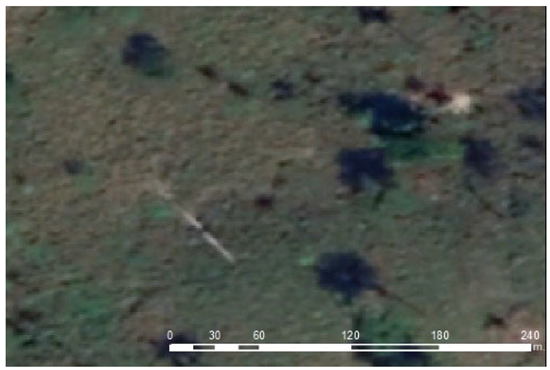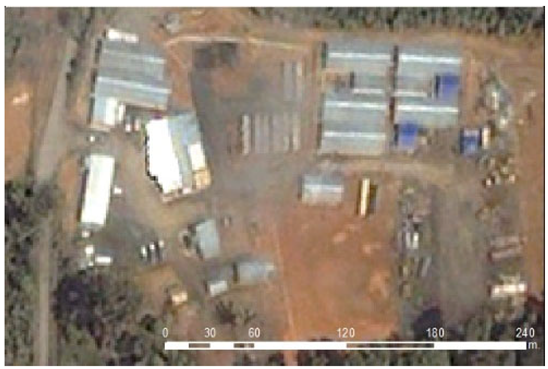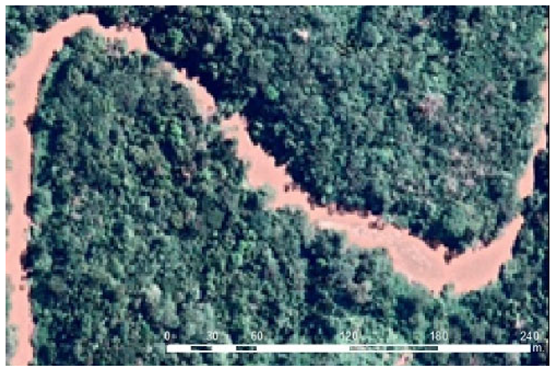Abstract
Land use and land cover change (LULC) is an essential component for the monitoring environmental change and managing natural resources in areas of high natural and cultural biodiversity, such as the Amazon biome. This study was conducted in in the northern Amazon of Ecuador, specifically in the Diversity and Life Zone (DLZ) of the Yasuní Biosphere Reserve (YBR). The general aim was to investigate the territorial dynamics of land use/land cover changes to support policies for environmental and sociocultural protection in the DLZ. Specific objectives included (i) mapping LULC spatial and temporal dynamics in the DLZ in the period from 1999 to 2018, (ii) identifying sensitive LULC hotspots within the DLZ, and (iii) defining the possible policy implications for sustainable land use in the DLZ. Multitemporal satellite imagery from the Landsat series was used to map changes in LULC, which were divided into three-time stages (1999–2009, 2009–2018, 1999–2018). We adopted open-access Landsat images downloaded from the United States Geological Survey (USGS). The processes for assessing LULC in the DLZ included (1) data collection and analysis, (2) data processing for remote sensing, (3) thematic land cover, and (4) homogenization and vectorization of images. The results showed that in the period 1999–2018, most of the uses and land cover were transformed into pastures in the DLZ. Therefore, it is important to improve territorial planning, to avoid conflicts between indigenous populations, migrant settlers, and uncontacted indigenous populations that live in the DLZ, within the YBR.
1. Introduction
Land use and land cover change (LULC) has become a fundamental and essential component in current strategies that concern monitoring environmental change and managing natural resources [1,2]. Increasing anthropogenic activities around the biosphere are causing large-scale alterations to the Earth’s land surface, affecting the efficiency of global systems [3]. LULC and its resources have been used for humans’ social, material, cultural, and spiritual needs, leading to significant changes [4,5]. Rapid changes in LULC, particularly in developing countries [6,7,8], have resulted in the depletion of vital resources, including water, soil, and vegetation [9,10]. However, due to their speed, extent, and intensity, they have numerous critical global implications [11,12], particularly on natural resources [12] and on greenhouse gas emissions from land use change [13,14,15]. The increasing change is alarming and may have a significant impact on the local [16], regional [17], national [18], and global environment [3,19].
Within the United Nations Sustainable Development Goals (SDGs), goal number 15 focuses on “promoting sustainable life on land” [20] and its sub-indicator 15.3.1 concerns the proportion of land that is degraded over the total land area. Researchers, policy makers, and planners use LULC information to determine changes in natural resources, including assessing growth patterns [21], to achieve the SDG 15′s Target 3: “By 2030, combat desertification, restore degraded land and soil, including land affected by desertification, drought and floods, and strive to achieve a land degradation-neutral world”. A better understanding of land dynamics requires the detection of LULC changes [22]. Empirical studies by researchers from various disciplines have shown that changes in LULC are key to various applications, such as hydrology, agriculture, forestry, the environment, geology, and ecology [1,2,23,24]. Many researchers argue that LULC change could result in an ecosystem imbalance and impacts on the environment caused by humans and their role in climate change [25,26,27,28].
In developing countries, resource bases, such as land, forests, and water, are declining significantly [29]. However, information on the rate of decline is often lacking [30]. Accurate information on LULC changes is needed to understand the root causes and environmental costs of such changes. Furthermore, analyzing the driving forces causing LULC change is essential to understand current changes and forecast future alterations [17].
The Northern Ecuadorian Amazon (NEA) is an area where various dynamics and complex interactions take place between the different local, national, and international actors identified, namely migrant settlers, emerging communities and market centers, indigenous peoples, oil and mining companies, and government and non-governmental agencies [17].
The following dynamics were identified: migrant settlers have migrated from different parts of Ecuador, especially the highlands, characterized by rural areas with high poverty rates, extremely concentrated land tenure, and smallholdings [31,32]; some migrant settlers are considered environmental refugees [33]. Emerging communities and market centers are expanding services, providing a source of off-farm employment for settlers, and affecting land use and land cover (LULC) in a direct and indirect manner [17]. Indigenous peoples, in response to declining per capita land tenure attributable to population growth [34], migrated north from the NEA, leaving their historic lands in the southern Ecuadorian Amazon [35,36]. These groups include the Waorani and Kichwa, who continue with their often-unsustainable traditional production systems [37,38] and coexist with the ecosystem services of the forest but are increasingly involved in market agriculture [39], wage employment [40,41], and other external agents, thereby transitioning to a market-oriented economy. It also comprises other indigenous people in voluntary isolation (Tagaeri and Taromenane), who live off shifting agriculture and services from the forest land [42,43]. Oil companies built the roads to lay pipelines and continue to find and extract more oil [44] in colonial and indigenous areas [45,46] and even in national parks [47], generating several oil spills in the process [48]. Government agencies, such as the Ministry of Environment (now the Ecuadorian Ministry of Environment, Water and Ecological Transition—MAATE, acronym in Spanish), are encouraged by certain Ecuadorian and international NGOs to set aside and monitor large areas of the Amazon for the conservation and protection of the region’s extraordinarily rich ecological and cultural diversity [49]. The relationships between these five actors are complex, partly due to feedback between spatial patterns and rates of LULC change in the NEA. Overall, LULC change associated with tropical deforestation is complex: population–environment linkages and feedback create dynamics with emergent properties, especially with the advance of the agricultural and development frontier [17].
The Yasuní Biosphere Reserve (YBR) has experienced different invasive territorial dynamics, such as oil activities, openings of road network, colonization processes and their consequences in deforestation, land use changes and impacts on fauna and flora, expansion of the agricultural frontier, logging, indiscriminate hunting and fishing, water pollution, and contamination by crop fertilizers [50,51,52,53]. These dynamics have caused (a) territorial conflicts and the mobility of the uncontacted indigenous peoples (Tagaeri and Taromenane), which have generated several incidents of aggression against migrant settlers, mestizo wage earners, and sedentary indigenous people in the area [54]; and (b) the intensification and extensification of colonization and agricultural processes on the main road (called Via Auca) and its offshoot roads [55,56]. In this context, in 2015, under the leadership of the Ministry of Agriculture and Livestock (MAG) in coordination with other government institutions, the creation of the Diversity and Life Zone (DLZ) was legalized, whose objective was special territorial management for the protection of migrant settlers, indigenous nationalities, and uncontacted indigenous peoples who live in the Yasuní National Park (YNP), Intangible Zone, or Zona Intangible Tagaeri Taromenane (ZITT) [57,58] and even outside these areas [59].
Given this background, the general aim of this research was to investigate the territorial dynamics of land use/land cover changes to support policies for environmental and sociocultural protection in the area Diversity and Life Zone (DLZ). Specific objectives included (i) mapping LULC spatial and temporal dynamics in the DLZ in the period from 1999 to 2018, (ii) identifying sensitive LULC hotspots within the DLZ, and (iii) defining the possible policy implications for sustainable land use.
This research is organized as follows: Section 2 describes the study area, the data, and the methodological process. The results with the historical changes and hotspots of LULC are described in Section 3, which includes the discussion and the policy implications for sustainable land use are described. Finally, the main conclusions of the research are described in Section 4.
2. Materials and Methods
2.1. Study Area
This study was conducted in the DLZ. It is located within the transition, buffer, and core areas of the Yasuní Biosphere Reserve in the northeast sector of the Ecuadorian Amazon Region. The zone is 116 km long and approximately four kilometers wide, parallel to the boundaries of the existing communities in the DLZ, and has a total area of 38,857.5 ha. The extension is distributed between the parishes of Taracoa (area: 787 ha; perimeter 27.26 km), Dayuma (area: 19,900 ha; perimeter 139 km), and Inés Arango (area: 17,354 ha; perimeter 125.72 km), all in the canton of Francisco de Orellana in the province of Orellana. The geographical limits of the DLZ are the Indiyama river to the north, the Tiwino river to the south, and both the limits of the Yasuní National Park (YNP) (982,300 ha) and the Waorani Ethnic Reserve (WER) (809,339 ha) to the east. The DLZ is overlapped by seven oil blocks and is located next to the ZITT and its buffer area (Figure 1).
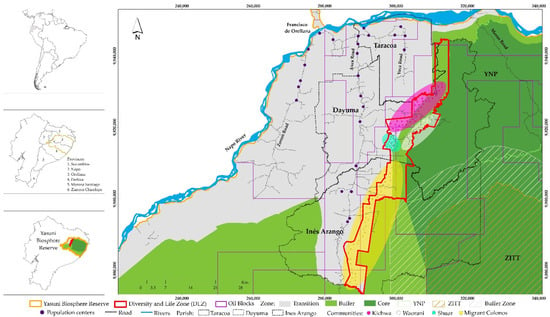
Figure 1.
Diversity and Life Zone located in the parishes of Taracoa, Dayuma, and Inés Arango, Yasuní Biosphere Reserve of the Ecuadorian Amazon Region.
2.2. Classification and Detection of Changes in the DLZ
For the classification and detection of changes in the DLZ, its surface area was divided into two zones: north and south, based on two criteria: (1) proximity to the most populated settlement (Coca City), and (2) the political and administrative division between the parishes (Taracoa, Dayuma, and Inés Arango) that overlap with the DLZ. Hereunder, the processes for assessing LULC in the DLZ are detailed: (1) data collection and analysis (Table 1, Figure 2), (2) data processing for remote sensing, (3) thematic land cover (Table 2, Figure 3), and (4) homogenization and vectorization of images (Figure 4).

Table 1.
Satellite images used in the LULC spatial analysis of the Life and Diversity Zone, Yasuní Biosphere Reserve of the Ecuadorian Amazon Region.
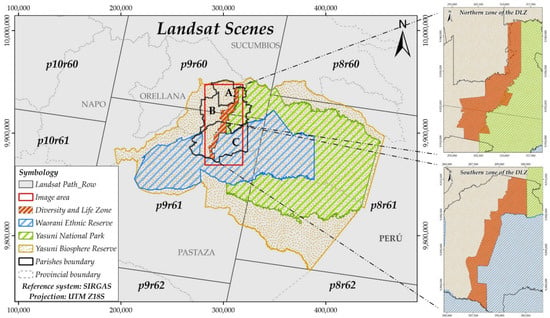
Figure 2.
Footprint of the two satellite images (Landsat 5, 7, and 8) in the Zone of Diversity and Life of the Ecuadorian Amazon Region. Parish boundaries: (A) Taracoa, (B) Dayuma, and (C) Inés Arango.

Table 2.
Land use and land cover (LULC) classification scheme.
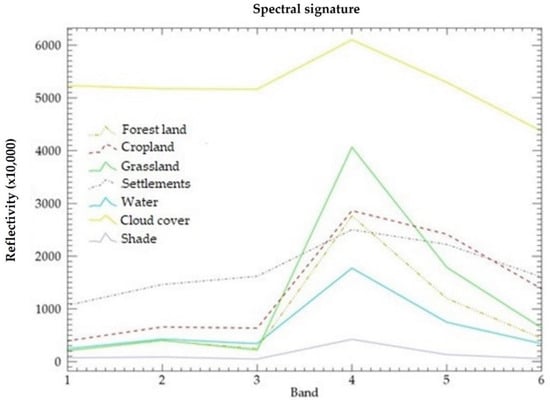
Figure 3.
Typical spectral signature resampled from Landsat 8 (2018) imageries for the Life and Diversity Zone, Yasuní Biosphere Reserve of the Ecuadorian Amazon Region.
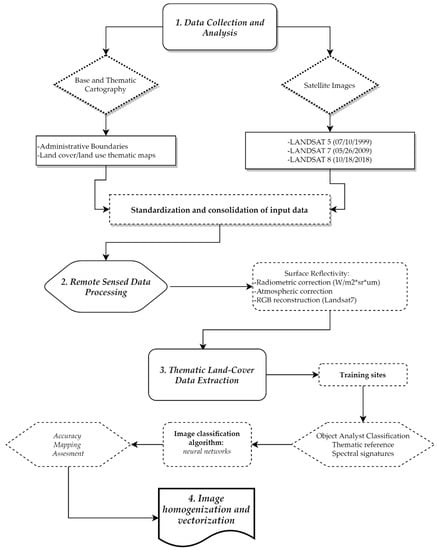
Figure 4.
Workflow for the LULC methodology, in the period from 1999–2018.
2.2.1. Data Collection and Analysis
Different Landsat satellite images were obtained from an altitude of 705 km and an inclination of 98°, with a periodicity of 16 days. The LULC spatial dynamics were analyzed using a time-frame of approximately 20 years (1999–2018), downloaded from the United States Geological Survey (USGS) Earth Explorer (https://earthexplorer.usgs.gov, accessed on 17 July 2019), with a spatial resolution of 30 m (Table 1). Two satellite images were used for each year of the study (Figure 2). The images were selected by trying to minimize the presence of clouds as much as possible, considering that the Ecuadorian Amazon Region, is located in the intertropical convergence zone, which is why it has the highest cloud cover in the world [60].
The descriptive statistics calculated were as follows: (1) global precision, which is the fraction between the correctly classified samples and the total pixels of the error matrix, being considered as a confidence or reliability interval, which can be obtained under a level of significance; (2) and the kappa index, which measures the difference between the agreement and the one that would be expected by means of randomization, trying to delimit the degree of adjustment due only to the accuracy of the classification [61] and the precision of the producer, which is the probability of correctly labeling a pixel of class Xi, whereas user precision measures the probability that a pixel labeled in class Xi actually corresponds to that class.
2.2.2. Data Processing for Remote Sensing
The images were standardized, reprojected into the planar coordinate system (SIRGAS, UTM Zone 18S/EPSG:31993), and duly corrected, minimizing atmospheric disturbances, thus allowing the data to be as close as possible to an ideal acquisition [61]. The first step was to perform a radiometric correction, which allows for the conversion of digital counts to physical magnitudes, specifically radiance values (W m−2 sr−1 µm−1), and then, through the use of radiative transfer models, mitigate the atmospheric effect, and thus obtain surface reflectivity values. Only for the Landsat 7 image, due to image stripes with no data related to the SLC-off failure (aer 2003), a simple interpolation was applied, which replaces empty pixels with their neighbors. Such a technique is called Neighborhood Similar Pixel Interpolation (NSPI) [62].
2.2.3. Thematic Land Cover
Prior to the extraction of information per se, the thematic legend was structured at a scale of 1:100,000, by identifying the following classes: forest land, cropland (as a traditional production system), grassland, settlements, and water (not identifying areas under the wetlands class) (Table 2). This classification is similar to level II of public institutions: the former Ministry of Agriculture, Livestock, Aquaculture and Fisheries (MAGAP), at present known as the Ministry of Agriculture and Livestock (MAG); the Ecuadorian Ministry of Environment, Water and Ecological Transition; and the former Ecuadorian Space Institute (IEE), now called the Military Geographic Institute (IGM) [63,64].
Subsequently, training samples were selected, using as secondary information, such as the land use and land cover map produced by SIGTIERRAS of Ecuador (http://ide.sigtierras.gob.ec/geoportal, accessed on 23 October 2019), scale 1:25,000. The number of training samples selected for every image ranged from 138 to 394 (Table 2). In addition, an object-based segmentation was applied to the input images prior to the application of the classification algorithm, and type spectral signatures were obtained from the images themselves (Figure 3), thus mitigating to the maximum error that could be made when selecting the samples.
The training samples collected were spatially distributed across each of the images, and, in terms of quantity, and were between 10a and 100a pixels [65], with “a” being the number of bands, hence the number of pixels fluctuated between at least 60 and 600 for each class. These samples were evaluated with the Jeffries Matusita index.
Once the key information was collected, the neural network classification technique was applied using layered feedback, making use of a logistic-type activation function, a hidden layer, and a training rate of 0.2. The neural network classifier simulates the biological processes of the human brain, through the multiple interconnections between neurons, also called interconnected processing nodes, which are used to develop models [66].
It is composed of three layers: the input layer represented by the training samples or data, from which the algorithm is learned; the hidden layer, where the weights are adjusted iteratively to provide an approximate output close to the desired one; and the output capacity that houses the results achieved [61]. The process culminates when an acceptable error is reached, thus being able to use this network in future predictions with an independent data set [67].
Subsequently, using the test samples (different from training samples), we evaluated the accuracy of the results obtained, through the following parameters: overall accuracy (OA) and kappa coefficient (K). All of this process was carried out in the ENVI 5.3 software.
2.2.4. Homogenization and Vectorization of Images
Finally, a smoothing filter was applied to the classified images to obtain greater homogenization and eliminate possible noise, and the product obtained was converted into vector format. The main steps of the data input and data processing are summarized by the workflow in Figure 4. According to Lencinas and Siebert [68], for scales of 1:100,000, the minimum mapping unit is 5 ha; however, to avoid loss of the extracted information, 1 ha was taken as the minimum unit as the image resolution was 30 m pixel−1.
3. Results and Discussion
3.1. Land Use and Land Cover (LULC) in the Life and Diversity Zone (1999–2018)
The validation of the LULC classifications and analysis in the DLZ, which was divided into northern and southern segments, is detailed below with respect to the overlap with the parishes of Taracoa, Dayuma, and Inés Arango (Figure 1).
3.1.1. Validation of Classifications
Overall, the LULC classification levels for the dates range between 98.0% and 99.6%, with Kappa concordance indices between 0.97 and 0.99. The accuracies per individual LULC class (i.e., user accuracy (UA) and producer accuracy (PA)) are shown in Table 3. According to the minimum accuracy of 85% set in the Anderson classification scheme, these Kappa values are satisfactory in all four classes [69].

Table 3.
Evaluation of the accuracy of the LULC classification in the Diversity and Life Zone in the Yasuní Biosphere Reserve of the Ecuadorian Amazon Region.
Once the training ROIs were defined and prior to performing the digital classifications, a spectral separability analysis was performed, taking the Jeffries–Matusita distance as an indicator, which must be greater than 1.8 to consider the absence of confusion between classes.
There are multiple ways that allow us to assess the reliability of results. One of them is through field campaigns or through information from official sources prepared close to our study. However, due to not having this possibility, we decided to make a comparison with the map of use and coverage of SIGTIERRAS, prepared in 2015, obtaining a degree of similarity of 88.7% (34,472.2 ha of 38,857.5 ha of DLZ) with respect to the classification of the image of the year 2018. It should be noted that the cartography prepared by the SIGTIERRAS is the only one available from the VDF. In addition, the technique used to derive the said product was visual interpretation using orthophotos.
3.1.2. Land Use and Landcover Change (LULC)
A. Northern zone of the DLZ (Dayuma and Taracoa Parishes)
The downward trend of forest land and the upward trend of the other classes are evident in Table 4 and Table 5, together with Figure 5, which summarize the LULC from 1999 to 2018 based on five classes extracted from the northern zone of the DLZ (the parishes of Dayuma and Taracoa). Furthermore, the spatial representation of LULC types from 1999 to 2018 is shown in Figure 6. In the year 1999, the LULC pattern as a percentage of the total area surveyed was dominated by forest, covering 95.73% of the total area surveyed, followed by herbaceous vegetation (1.74%), traditional production systems (1.41%), water (0.75%), and settlements (0.05%). Trend changes were observed for all LULCs in the years 2009 and 2018.

Table 4.
LULC classification results of 1999, 2009, and 2018 images, showing the area of each class and percentages per class in the DLZ’s northern zone (Dayuma and Taracoa) in the Yasuní Biosphere Reserve of the Ecuadorian Amazon Region.

Table 5.
Results of the LULC classification for 1999, 2009, and 2018 images, showing the area changed and percentages in the DLZ’s northern zone (Dayuma and Taracoa) in the Yasuní Biosphere Reserve of the Ecuadorian Amazon Region.
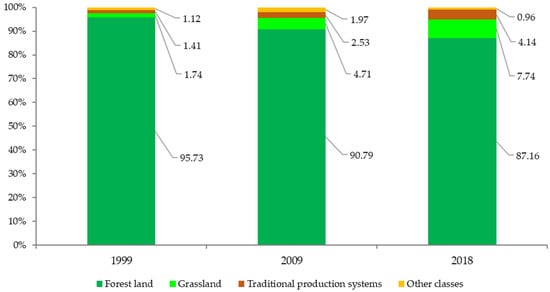
Figure 5.
LULC graph for 1999, 2009, and 2018 in the DLS’s northern zone (Dayuma and Taracoa parishes) in the Yasuní Biosphere Reserve of the Ecuadorian Amazon Region.
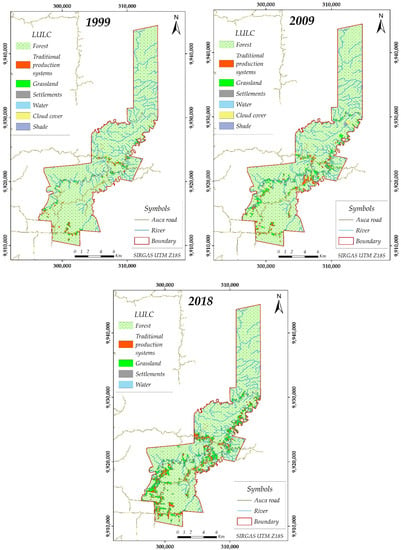
Figure 6.
LULC maps for 1999, 2009, and 2018 of the DLZ’s northern zone (Dayuma and Taracoa) in the Yasuní Biosphere Reserve of the Ecuadorian Amazon Region.
In the DLZ, from 1999 onwards, forest land decreased by 4.95% and 8.57% in 2009 and 2018, respectively (Figure 5), which is consistent with the trend reported by several authors who stated that deforestation is increasing in tropical forests [70,71]. As widely reported in the literature, Western Amazon has been recognized for decades as one of the 14 major deforestation fronts globally [72,73]. In fact, Ecuador, Peru, and Bolivia are three of the 15 countries that have lost the highest amount of primary forest area between 1990 and 2015 [74]. In the Ecuadorian Amazon Region, the perimeters of protected areas and intangible zones were reported to be more vulnerable to deforestation [56] and problems have been intensified by oil activity [7,75,76,77], access to road systems [78,79,80], and by conversion to agriculture [81,82,83,84]. Furthermore, these areas experience the dynamics of timber supply from small producers (mestizo settlers and indigenous) to urban centers [85], as Amazonian cities are the first link to final markets through an extended intermediation network [86]. The precarious formal obtaining of deeds for indigenous and settler lands is a weakness in the DLZ, as it has been recurrently demonstrated that formal land deeds are an effective means of buffering deforestation in much of the Amazon biome [87,88].
In relation to the classification of traditional production systems for the years 2009 and 2018, there were increases of 2.53% and 4.14%, respectively (Table 4). Overall, from 1999 to 2018, there was an increase of 2.73% (Table 5). The dynamics of agriculture are mostly concentrated near roads (Figure 6), driven by farmers’ colonization, which is attributed to different state laws [89,90] and the beginning of oil extraction [91], which promoted migration to the Ecuadorian Amazon Region and impacted on land use [92], leading to deforestation and land use change [93]. This LULC dynamic has been the main source of food and livelihood for rural households, a condition very similar to what happened in the Brazilian Amazon during its colonization processes [94]. At present, white, mestizo, and indigenous migrants carry out unsustainable farming practices, mainly based on conventional intensive agriculture using agrochemicals in their production systems, probably influenced by the generation of higher incomes, availability of credit, government social transfers, and land use patterns towards monocultures [95]. However, this type of intensification also brings health issues to the indigenous and migrant settler population [96] as well to ecosystem degradation [97,98].
The expansion of herbaceous vegetation areas from 1990 to 2018 (Table 4) and between analysis periods (Table 5) evidences a 5-fold and 2-fold lower proportion in 1990 and 2009, respectively, compared to 2018. These results may reflect the shift from subsistence to market agriculture in migrant settler and indigenous populations, driven by the diversification of economic and agricultural risk [99], and may also be influenced by the precarious sustainability of traditional production systems, namely: Kinkore (Waorani), Aja (Shuar), Chakra (Kichwa), and agroforestry systems (migrant settlers) assessed under social, environmental, economic, and governance dimensions [37,38,100].
In terms of infrastructure, the results obtained (Table 4 and Table 5) and represented in Figure 6 corroborate with the dynamics analyzed in Dayuma in 1982, 1990, 2000, and 2014 [77]. There is evidence of the expansion of road systems as well as non-indigenous and indigenous settlements due to oil activity and processes of migration and colonization [77]. Similar dynamics have occurred in Machadinho D’Oeste (abbreviated as Machadinho), a municipality located in the state of Rondônia in the southwestern part of the Brazilian Amazon. Machadinho lies within the so-called “deforestation arc”, the area with the highest historical rates of primary forest conversion in the Brazilian Amazon [101]. Likewise, in western Uganda, migration has transformed the forest landscape into patches of subsistence production systems in the area surrounding Kibale National Park, causing substantial impacts on biodiversity and the climate [102]. Furthermore, it has been shown that rapid population growth in tropical countries will significantly increase the intensity of deforestation by 2030 [103]. This poses a major challenge for practitioners seeking to balance rural development and conservation policies in indigenous territories and mega-diverse areas [39].
The inter-annual variations (Table 5) demonstrate that the forest land has steadily decreased, reaching a loss of 1799.84 ha during the period studied, representing approximately 9% in the DLZ’s northern zone. It has been replaced with areas related to human intervention, e.g., settlements, traditional production systems, and grassland.
The variation of the water (with a surface area totaling <2% of the total DLZ and an inter-annual variation of <0.5%) is mainly due to the complexity of detecting it in the satellite image, since the spatial resolution of the image is 30 m versus 60 m, which is the average width of the meandering rivers in the study area, requiring several pixels to identify an object.
Another way of showing the dynamics between classes is through spatial analysis, where the geospatial location of each class plays a key role. Between 1999 and 2009, there was an 8.58% change in cover type (1798.82 ha); between 2009 and 2018, the change totaled 12.16%; and over the entire period studied, it was 15.39%. Specifically, 87.39% (17,556.6 ha) of the forest land’s initial area (20,089.97 ha) has remained intact during the period 1999–2018.
B. Southern zone of the DLZ (Inés Arango Parish)
LULC analyses in the DLZ’s southern zone (Inés Arango Parish) do not differ from the results obtained in the northern zone (Dayuma and Taracoa). In addition, the spatial representation of LULC types from 1999 to 2018 is shown in Figure 7. Starting with a study area of 17,872.17 ha, the LULC pattern in 1999 was dominated by forest land (95.29%), followed by grassland (2.51%), traditional production systems (0.71%), water (0.31%), and settlements (0.14%) with a minor difference by class of 0.44%, 0.77%, 0.44%, and 0.09%, respectively, compared to the northern zone. Table 6 and Table 7, together with Figure 8, summarize the dynamics of LULC from 1999 to 2018, based on the five classes extracted from the southern zone. As regards the southern zone in 2018, there was a minor difference between the classes studied with respect to the northern zone: forest land (4.41%), traditional productive systems (2.08%), grassland (1.89%), settlements (0.14%), and water (0.29%). These differences in LULC between DLZ zones may arise from the places’ distances to the most densely populated areas (Figure 1) and poor road conditions (Via Auca). These results are consistent with the theory that the closer populations live to towns or cities, the greater the transformation of forest land to other uses [77], given that an increase in geographic accessibility provides an incentive to expand agriculture and reap rewards from the sale of timber products and agricultural crops in market centers and via product intermediaries [104].
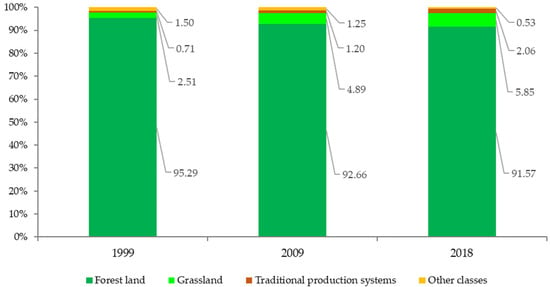
Figure 7.
LULC graph for 1999, 2009, and 2018 of the DLZ’s southern zone (Inés Arango Parish) in the Yasuní Biosphere Reserve of the Ecuadorian Amazon Region.

Table 6.
LULC classification results for the 1999, 2009, and 2018 images, showing the area of each class and the percentages per class in the DLZ’s southern zone (Inés Arango Parish) in the Yasuní Biosphere Reserve of the Ecuadorian Amazon Region.

Table 7.
Results of the LULC classification for 1999, 2009, and 2018 images, showing the area changed and percentage in the DLZ’s southern zone (Inés Arango Parish) in the Yasuní Biosphere Reserve of the Ecuadorian Amazon Region.
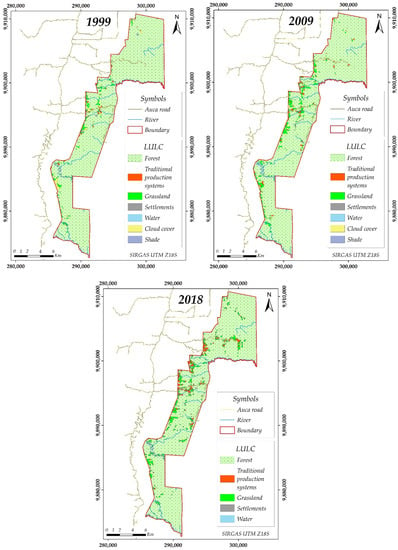
Figure 8.
LULC maps for 1999, 2009, and 2018 of the DLZ’s southern zone (Inés Arango Parish) in the Yasuní Biosphere Reserve of the Ecuadorian Amazon Region.
Regarding the forest land, there is evidence of a decrease in its surface area (Table 6 and Table 7), even though there are controls enforced upon the commercialization of timber and its legality [105]. In tropical countries, timber legality control is costly and often quite ineffective, hence local participants constantly find ways to circumvent the law, as timber contributes to the income of mestizo settler and indigenous populations [106]. Almost all participants in the timber value chain in the Ecuadorian Amazon Region, Peru, and Bolivia comply to some extent with the law but also engage in some illegal practices [107,108].
Regarding traditional productive systems, between the periods 1999–2009 and 2009–2018, they increased by 0.33%, reaching 1.15% in the period 1999–2018 (Table 7). Considering that most of the inhabitants in the southern zone are migrant settlers and their main livelihood derives from oil company wages, productive systems have been lost, mostly due to the abandonment of agricultural land driven by socio-economic factors [109], evidenced by the increase in grassland (Table 6). Similar scenarios can be be found in the Albertine Graben region on the border between Uganda and the Democratic Republic of Congo, where oil activity has generated negative social and environmental impacts [110,111], potentially eroding the relationship between people and local-national government, creating economic distortion, increased corruption, and internal tensions [112]. Additionally, the abandonment of agricultural land has increased the workload for women [113,114].
The study of LULC in the northern Ecuadorian Amazon during 1973, 1986, 1989, 1996, and 1999 [113] agrees with the dynamics of the settlements class in the northern and southern zones of the DLS (Figure 6 and Figure 8, respectively). Similar landscape alterations are evident from the LULC study in oil block No. 47, located in the province of Orellana (Ecuadorian Amazon Region) [16].
The geospatial dynamics between all classes shows a variability of 6.46% (1154.31 ha) between 1999 and 2009, 8.56% between 2009 and 2018, and 11.27% over the entire period studied. As for forest land, 92% (15,665.86 ha) of its initial area (17,030.23 ha) was kept intact during the period 1999–2018.
3.1.3. Hotspots of LULC within the DLZ
In the DLZ, four LULC hotspots were identified: two in the north (Figure 9) and two in the south of the DLZ (Figure 10). The dynamics of the LULC hotspots found follow the patterns of the road networks built by the oil companies [115,116], and the banks of the rivers [117]. LULC hotspots are home to indigenous populations (Waorani, Shuar and Kichwa) and migrant settlers (Figure 1) native to the Andes and the coast of Ecuador [118]. Similar LULC dynamics are found in the Apyterewa Indigenous Land (Eastern Brazilian Amazon), where the Parakanã indigenous group inhabits and the LULC change correlates with the roads and rivers of the Xingu River basin [119].
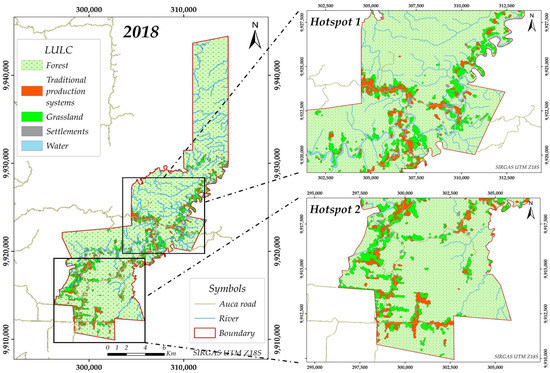
Figure 9.
LULC hotspots in the northern zone of the DLZ (Dayuma and Taracoa) in the Yasuní Biosphere Reserve of the Ecuadorian Amazon Region.

Figure 10.
LULC hotspots in the DLZ’s southern zone (Inés Arango Parish) in the Yasuní Biosphere Reserve of the Ecuadorian Amazon Region.
Among the indigenous peoples who inhabit the LULC hotspots, it is observed that in the territory occupied by the Waorani indigenous people, there is minimal alteration of the forest landscape. (Figure 9—Hotspot 1), which correlates with the manifesto that the Waorani, who live near the Via Auca, depend on the paid positions of the oil companies and there is little or no interest in the production of food in the Kinkore [120] and there is extensification of the Ajas (Figura 10—Hotspot 1) in the territory occupied by the Shuar indigenous, who migrated from the south of the Ecuadorian Amazon Region [121].
3.1.4. Potential Policy Implications for Sustainable Land Use in the DLZ
The results show changes in the LULC dynamics from 2009 to 2018, where an increase in deforestation and an expansion of different traditional production systems are evident. Ecuador’s current agricultural policy has proposed sustainable agriculture and the rescue of traditional production systems as a tool to achieve food security, poverty alleviation, and environmental conservation [122]. Nonetheless, it is necessary to put these statements into practice by taking different local realities into account, as in those described in the DLZ, by implementing real actions in a participatory manner between indigenous and migrant settlers, with the aim of establishing sustainable intensification practices that will allow migrant settlers and indigenous populations to increase their income without having to do so at the cost of increasing the surface area [123]. What is more, these results suggest an evaluation of financial incentive programs that could reduce deforestation in this area, especially in terms of use and distribution, as well as in the analysis of priority areas at risk of deforestation, including the DLZ [56].
The Forest Incentives Program or “Socio Bosque” consists of the transfer of a direct monetary incentive per hectare of native forest and other native ecosystems to individual landowners or indigenous communities that protect these ecosystems, through voluntary conservation agreements [124], with the values of the monetary incentives depending on the range of hectares conserved (Table 8) [125]. According to our findings, this program should be reviewed in order to refine its approach, as its spatial distribution has not prioritized the most vulnerable areas, which could lead to a limited effect on reducing future deforestation. Although the implementation of this program has been a beneficial example of public policy aimed at environmental conservation and rural poverty alleviation, we consider it vital to revise the program to integrate factors, such as vulnerability to deforestation and alternative territorial management strategies that go beyond conservation and address sustainable land management in the DLZ [126].

Table 8.
Monetary incentive levels provided in exchange for enrollment.
In general terms, the advancement of the agricultural frontier, and the increase in deforestation and infrastructure in the DLZ is evident. To this end, the achievement of SDG 15 must be promoted by improving the quality of governance in terms of production and conservation of natural resources, as these elements are key to minimizing land-use change [126]. It is essential to implement practical actions aimed at the sustainability of traditional production systems worked in by indigenous and migrant settlers [38,100] in order to achieve the Sustainable Development Goals for 2030, for example, the promotion of field schools that encourage the rescue of these traditional systems, as well as the consumption of food products from the systems.
4. Conclusions
The spatial analysis, based on open-access spatial data from Landsat mission, made it possible to quantify and map the pattern of LULC in the Yasuní Biosphere Reserve’s DLZ by focusing on changes in the northern and southern zones. Spatial analysis on a time scale of 20 years (1999–2018) allowed identification of LULC changes in sensitive areas, including the detection of important hotspots of deforestation. Spatial analysis and mapping of LULC changes within the DLZ provide a basis for strategic and inclusive territory planning, management, and decision-making both for biodiversity conservation and human rights protection, by improving livelihood strategies for indigenous Waorani, Shuar, Kichwa, and migrant settler communities, and as a tool for precautionary protection measures for uncontacted indigenous peoples. Additionally, the use of very high-resolution multispectral satellite imagery can provide more details of the changes in the region. Based on the LULC analyses of Landsat data for the years 1999, 2009, and 2018, it was found that the LULC trends varied; hence, these results provide an important platform for further analysis of LULC.
In the period 1999–2018, most land uses and land cover were transformed into grasslands in the northern and southern zone of the DLZ. This indicates that the expansion of grassland was the result of deforestation, probably due to infrastructure for oil activity and the intensification of traditional productive systems for the integration of indigenous peoples into the market economy, especially in the northern zone of the DLZ. In the southern zone, the LULC values were found to be lower because there is little incidence of oil activities, fewer infrastructures, and the existence of migration processes of migrant settlers to the city. In general, of the assessed LULC classes, they were observed in an upward direction in the DLZ. Therefore, proper management of the DLZ, including land use planning, is required to avoid resource use conflicts between indigenous communities, migrant settlers, uncontacted indigenous peoples, and different local and international actors in the northern and southern zones of the DLZ.
Author Contributions
Conceptualization: M.H.-R., F.C.-T., C.G.H.D.-A., B.T. and S.E.P.; Methodology: M.H.-R., F.C.-T. and B.T.; Software: M.H.-R. and F.C.-T.; Writing-Original Draft Preparation: M.H.-R., F.C.-T. and B.T.; Writing—Review & Editing: M.H.-R., B.T., E.T., C.G.H.D.-A. and S.E.P. All authors have read and agreed to the published version of the manuscript.
Funding
This research carried out with small funds of from the project: “Analysis of sustainability and climate change in indigenous farmers and settlers of the Yasuní Biosphere Reserve, Ecuadorian Amazon” of the Universidad Estatal Amazónica (Ecuador), this research has not received external funds.
Acknowledgments
We want to thank the Universidad Estatal Amazónica and Military Geographic Institute, (Quito–Ecuador) for the support, for the realization of this research.
Conflicts of Interest
The authors declare no conflict of interest.
References
- Torres, B.; Andrade, L.; Navarrete, A.T.; Vasco, C.; Robles, M. Cambio de uso del suelo en paisajes agrícolas-forestales: Análisis espacial en cinco comunidades Kichwas de la Región Amazónica Ecuatoriana. Rev. Amaz. Cienc. Tecnol. 2018, 7, 105–118. [Google Scholar]
- Barreto-Álvarez, D.E.; Heredia-Rengifo, M.G.; Padilla-Almeida, O.; Toulkeridis, T. Multitemporal Evaluation of the Recent Land Use Change in Santa Cruz Island, Galapagos, Ecuador. In Conference on Information and Communication Technologies of Ecuador; Springer: Cham, Switzerland, 2020; pp. 519–534. [Google Scholar]
- Lambin, E.F.; Geist, H.J.; Lepers, E. Dynamics of land-use and land-cover change in tropical regions. Annu. Rev. Environ. Resour. 2003, 28, 205–241. [Google Scholar] [CrossRef] [Green Version]
- Armenteras, D.; Murcia, U.; González, T.M.; Barón, O.J.; Arias, J.E. Scenarios of land use and land cover change for NW Amazonia: Impact on forest intactness. Glob. Ecol. Conserv. 2019, 17, e00567. [Google Scholar] [CrossRef]
- Haindongo, P.N.; Kalumba, A.M.; Orimoloye, I.R. Local people’s perceptions about Land Use Cover Change (LULCC) for sustainable human wellbeing in Namibia. GeoJournal 2020, 1–15. [Google Scholar] [CrossRef]
- Lu, D.; Li, G.; Moran, E.; Hetrick, S. Spatiotemporal analysis of land-use and land-cover change in the Brazilian Amazon. Int. J. Remote. Sens. 2013, 34, 5953–5978. [Google Scholar] [CrossRef] [Green Version]
- Halmy, M.W.A.; Gessler, P.E.; Hicke, J.A.; Salem, B.B. Land use/land cover change detection and prediction in the north-western coastal desert of Egypt using Markov-CA. Appl. Geogr. 2015, 63, 101–112. [Google Scholar] [CrossRef]
- Wang, C.; Yang, Y. An overview of farmers’ livelihood strategy change and its effect on land use/cover change in developing countries. Prog. Geogr. 2012, 31, 792–798. [Google Scholar]
- Bruijnzeel, L.A. Hydrological functions of tropical forests: Not seeing the soil for the trees? Agric. Ecosyst. Environ. 2004, 104, 185–228. [Google Scholar] [CrossRef]
- Akinyemi, F.O. Vegetation Trends, Drought Severity and Land Use-Land Cover Change during the Growing Season in Semi-Arid Contexts. Remote Sens. 2021, 13, 836. [Google Scholar] [CrossRef]
- Foley, J.A.; De Fries, R.; Asner, G.P.; Barford, C.; Bonan, G.; Carpenter, S.R.; Stuart Chapin, F.; Coe, M.T.; Daily, G.C.; Gibbs, H.K.; et al. Global consequences of land use. Science 2005, 309, 570–574. [Google Scholar] [CrossRef] [Green Version]
- Hansen, M.C.; Potapov, P.V.; Moore, R.; Hancher, M.; Turubanova, S.A.; Tyukavina, A.; Thau, D.; Stehman, S.V.; Goetz, S.J.; Thomas, R.; et al. High-resolution global maps of 21st-century forest cover change. Science 2013, 342, 850–853. [Google Scholar] [CrossRef] [PubMed] [Green Version]
- Searchinger, T.D.; Wirsenius, S.; Beringer, T.; Dumas, P. Assessing the efficiency of changes in land use for mitigating climate change. Nature 2018, 564, 249–253. [Google Scholar] [CrossRef]
- Gerssen-Gondelach, S.J.; Lauwerijssen, R.B.; Havlík, P.; Herrero, M.; Valin, H.; Faaij, A.P.; Wicke, B. Intensification pathways for beef and dairy cattle production systems: Impacts on GHG emissions, land occupation and land use change. Agric. Ecosyst. Environ. 2017, 240, 135–147. [Google Scholar] [CrossRef]
- Lal, R.; Kimble, J.M.; Stewart, B.A. (Eds.) Global Climate Change and Tropical Ecosystems, 1st ed.; CRC Press: Boca Raton, FL, USA, 2000. [Google Scholar] [CrossRef]
- Llerena-Montoya, S.; Velastegui-Montoya, A.; Zhirzhan-Azanza, B.; Herrera-Matamoros, V.; Adami, M.; de Lima, A.; Moscoso-Silva, F.; Encalada, L. Multitemporal analysis of land use and land cover within an oil block in the Ecuadorian Amazon. ISPRS Int. J. Geo-Inf. 2021, 10, 191. [Google Scholar] [CrossRef]
- Mena, C.F.; Walsh, S.J.; Frizzelle, B.G.; Xiaozheng, Y.; Malanson, G.P. Land use change on household farms in the Ecuadorian Amazon: Design and implementation of an agent-based model. Appl. Geogr. 2011, 31, 210–222. [Google Scholar] [CrossRef] [PubMed] [Green Version]
- Vanacker, V.; Molina, A.; Torres, R.; Calderon, E.; Cadilhac, L. Challenges for research on global change in mainland Ecuador. Neotrop. Biodivers. 2018, 4, 114–118. [Google Scholar] [CrossRef] [Green Version]
- Noh, J.K.; Echeverria, C.; Kleemann, J.; Koo, H.; Fürst, C.; Cuenca, P. Warning about conservation status of forest ecosystems in tropical Andes: National assessment based on IUCN criteria. PLoS ONE 2020, 15, e0237877. [Google Scholar] [CrossRef]
- UN. Good Practice Guidance for Assessing UN Sustainable Development Goal Indicator 15.3.1: Proportion of Land That Is Degraded over Total Land Area. Annex 1: Land Cover and Land Cover Change 2017. Available online: https://unstats.un.org/unsd/envaccounting/ceea/meetings/twelfth_meeting/UNCCD_Annex1_Landcover_20170421.pdf (accessed on 1 January 2020).
- Nepal, P.; Khanal, N.R.; Zhang, Y.; Paudel, B.; Liu, L. Land use policies in Nepal: An overview. Land Degrad. Dev. 2020, 31, 2203–2212. [Google Scholar] [CrossRef]
- Yu, W.; Zang, S.; Wu, C.; Liu, W.; Na, X. Analyzing and modeling land use land cover change (LUCC) in the Daqing City, China. Appl. Geogr. 2011, 31, 600–608. [Google Scholar] [CrossRef]
- Joshi, P.K.; Kumar, M.; Paliwal, A.; Midha, N.; Dash, P.P. Assessing impact of industrialization in terms of LULC in a dry tropical region (Chhattisgarh), India using remote sensing data and GIS over a period of 30 years. Environ. Monit. Assess. 2009, 149, 371–376. [Google Scholar] [CrossRef]
- Gomes, L.C.; Bianchi, F.J.; Cardoso, I.M.; Fernandes Filho, E.I.; Schulte, R.P. Land use change drives the spatio-temporal variation of ecosystem services and their interactions along an altitudinal gradient in Brazil. Landsc. Ecol. 2020, 35, 1571–1586. [Google Scholar] [CrossRef]
- Mataveli, G.A.; Chaves, M.E.; Brunsell, N.A.; Aragão, L.E. The emergence of a new deforestation hotspot in Amazonia. Perspect. Ecol. Conserv. 2021, 19, 33–36. [Google Scholar]
- Lambin, E.F. Global land-use and land-cover change: What have we learned so far? Glob. Chang. News 2001, 46, 27–30. [Google Scholar]
- Dos Santos, J.Y.G.; Montenegro, S.M.G.L.; da Silva, R.M.; Santos, C.A.G.; Quinn, N.W.; Dantas, A.P.X.; Neto, A.R. Modeling the impacts of future LULC and climate change on runoff and sediment yield in a strategic basin in the Caatinga/Atlantic forest ecotone of Brazil. Catena 2021, 203, 105308. [Google Scholar] [CrossRef]
- Dosdogru, F.; Kalin, L.; Wang, R.; Yen, H. Potential impacts of land use/cover and climate changes on ecologically relevant flows. J. Hydrol. 2020, 584, 124654. [Google Scholar] [CrossRef]
- Smith, P.; House, J.I.; Bustamante, M.; Sobocká, J.; Harper, R.; Pan, G.; Oeste, P.C.; Clark, J.M.; Adhya, T.; Rumpel, C.; et al. Global change pressures on soils from land use and management. Glob. Chang. Biol. 2016, 22, 1008–1028. [Google Scholar] [CrossRef] [PubMed]
- Said, M.Y.; Naini, I.; Douglis, C.; Opio, C.; Gerber, P. Sustaining Communities, Livestock and Wildlife. A Guide to Participatory Land-Use Planning; FAO: Roma, Italy, 2009. [Google Scholar]
- Bilsborrow, R.E.; Barbieri, A.F.; Pan, W. Changes in population and land use over time in the Ecuadorian Amazon. Acta Amaz. 2004, 34, 635–647. [Google Scholar] [CrossRef]
- Barbieri, A.F.; Bilsborrow, R.E.; Pan, W.K. Farm household lifecycles and land use in the Ecuadorian Amazon. Popul. Environ. 2005, 27, 1–27. [Google Scholar] [CrossRef]
- Bates, D.C. Environmental refugees? Classifying human migrations caused by environmental change. Popul. Environ. 2002, 23, 465–477. [Google Scholar] [CrossRef]
- Rudel, T.K.; Bates, D.; Machinguiashi, R. A tropical forest transition? Agricultural change, out-migration, and secondary forests in the Ecuadorian Amazon. Ann. Assoc. Am. Geogr. 2002, 92, 87–102. [Google Scholar] [CrossRef]
- Bremner, J.; Lu, F. Common property among indigenous peoples of the Ecuadorian Amazon. Conserv. Soc. 2006, 4, 499–521. [Google Scholar]
- Saqalli, M.; Béguet, E.; Maestripieri, N.; Garine, E.D. "Somos Amazonia" a New Inter-indigenous Identity in the Ecuadorian Amazonia: Beyond a Tacit jus aplidia of Ecological Origin? Perspect. Geo. 2020, 25, 12–34. [Google Scholar] [CrossRef]
- Heredia, M.; Bravo, C.; Torres, B.; Alemán, R. Innovación para el fortalecimiento de capacidades sobre sostenibilidad de los recursos naturales en poblaciones indígenas y mestizas–colonas: Reserva de Biosfera Yasuní. Rev. Ibérica Sist. Tecnol. Inf. 2020, E25, 103–116. [Google Scholar]
- Heredia, M.; Falconí, A.K.; Barreto, D.; Amores, K.; Jamil, H.; Torres, B. Conductas sustentables sobre el marco de evaluación SAFA-FAO: Un aporte para poblaciones rurales vulnerables de la Amazonía. Rev. Ibérica Sist. Tecnol. Inf. 2020, E33, 312–326. [Google Scholar]
- Vasco, C.; Bilsborrow, R.; Torres, B.; Griess, V. Agricultural land use among mestizo colonist and indigenous populations: Contrasting patterns in the Amazon. PLoS ONE 2018, 13, e0199518. [Google Scholar] [CrossRef]
- Vasco, C.; Valdiviezo, R.; Hernández, H.; Tafur, V.; Eche, D.; Jácome, E. Empleo no agrícola, tala de Forest lands y uso de recursos naturales: Evidencia de la Amazonía ecuatoriana. Sustainability 2020, 12, 4515. [Google Scholar] [CrossRef]
- Torres, B.; Vasco, C.; Günter, S.; Knoke, T. Determinants of Agricultural Diversification in a Hotspot Area: Evidence from Colonist and Indigenous Communities in the Sumaco Biosphere Reserve, Ecuadorian Amazon. Sustainability 2018, 10, 1432. [Google Scholar] [CrossRef] [Green Version]
- Heredia, M.; Díaz-Ambrona, C.G. Comportamiento demográfico: Dinámico—Probabilístico de los pueblos indígenas en aislamiento de la amazonía ecua toriana. AXIOMA 2019, 20, 25–34. [Google Scholar]
- Wassestorm, R.; Álvarez, K.; Baihua, P.; Kimerling, J.; De Marchi, M.; Pappalardo, S.; Codato, D.; Diantini, A.; Ferrarese, F.; Ponce, P.; et al. Zona Intangible del Yasuní: Entre el Manejo Territorial y la Geografía Imaginada; Abya Yala: Quito, Ecuador, 2018; ISSN 978-9942-09-523-7. [Google Scholar]
- Mena, C.F.; Laso, F.; Martinez, P.; Sampedro, C. Modeling Road building, deforestation and carbon emis sions due deforestation in the Ecuadorian Amazon: The potential impact of oil frontier growth. J. Land Use Sci. 2017, 12, 477–492. [Google Scholar] [CrossRef]
- Diantini, A.; Pappalardo, S.E.; Powers, T.E.; Codato, D.; Fera, G.D.; Heredia-R, M.; Facchinelli, F.; Crescini, E.; Marchi, M.D. Is this a Real Choice? Critical Exploration of the Social License to Operate in the Oil Extraction Context of the Ecuadorian Amazon. Sustainability 2020, 12, 8416. [Google Scholar] [CrossRef]
- Carlson, C.; Ella, V.H. Indigenous Communities versus Oil Companies: Identifying Trends in Tactics and Success of Indigenous-Led Anti-Petroleum Movements in the Ecuadorian Amazon. 2020. Independent Study Project (ISP) Collection. 3322. Available online: https://digitalcollections.sit.edu/isp_collection/3322 (accessed on 15 July 2020).
- Bozigar, M.; Gray, C.L.; Bilsborrow, R.E. Oil extraction and indigenous livelihoods in the Northern Ecuadorian Amazon. World Dev. 2016, 78, 125–135. [Google Scholar] [CrossRef] [PubMed] [Green Version]
- Rivera-Parra, J.L.; Vizcarra, C.; Mora, K.; Mayorga, H.; Dueñas, J.C. Spatial distribution of oil spills in the northeastern Ecuadorian Amazon: A comprehensive review of possible threats. Biol. Conserv. 2020, 252, 108820. [Google Scholar] [CrossRef]
- Lessmann, J.; Fajardo, J.; Muñoz, J.; Bonaccorso, E. Large expansion of oil industry in the Ecuadorian Amazon: Biodiversity vulnerability and conservation alternatives. Ecol. Evol. 2016, 6, 4997–5012. [Google Scholar] [CrossRef] [Green Version]
- Cuesta, F.; Peralvo, M.; Merino-Viteri, A.; Bustamante, M.; Baquero, F.; Freile, J.F.; Priscilla Muriel, P.; Torres-Carvajal, O. Priority areas for biodiversity conservation in mainland Ecuador. Neotrop. Biodivers. 2017, 3, 93–106. [Google Scholar] [CrossRef]
- Espinosa, S.; Celis, G.; Branch, L.C. When roads appear jWaterrs decline: Increased access to an Amazonian wilderness area reduces potential for jWaterr conservation. PLoS ONE 2018, 13, e0189740. [Google Scholar] [CrossRef] [Green Version]
- Veil, J.A.; Puder, M.G.; Elcock, D.; Redweik, R.J., Jr. Un Documento Técnico que Describe el Water Producida a Partir de la Producción de Petróleo Crudo, Gas Natural y Metano de Carbón (No. ANL/EA/RP-112631); Laboratorio Nacional Argonne: Lemont, IL, USA, 2004. [Google Scholar]
- Barraza, F.; Schreck, E.; Lévêque, T.; Uzu, G.; López, F.; Ruales, J.; Prunierd, J.; Marquet, A.; Mauricio, L. Cadmium bioaccumulation and gastric bioaccessibility in cacao: A field study in areas impacted by oil activities in Ecuador. Environ. Pollut. 2017, 229, 950–963. [Google Scholar] [CrossRef] [PubMed]
- Pappalardo, S.E.; De Marchi, M.; Ferrarese, F. Uncontacted Waorani in the Yasuní Biosphere Reserve: Geographical Validation of the Zona Intangible Tagaeri Taromenane (ZITT). PLoS ONE 2013, 8, e66293. [Google Scholar] [CrossRef] [Green Version]
- Holland, M.B.; De Koning, F.; Morales, M.; Naughton-Treves, L.; Robinson, B.E.; Suárez, L. Complex tenure and deforestation: Implications for conservation incentives in the Ecuadorian Amazon. World Dev. 2014, 55, 21–36. [Google Scholar] [CrossRef]
- Bonilla-Bedoya, S.; Estrella-Bastidas, A.; Molina, J.R.; Herrera, M.Á. Socioecological system and potential deforestation in Western Amazon Forest landscapes. Sci. Total Environ. 2018, 644, 1044–1055. [Google Scholar] [CrossRef]
- Presidencia de la Republica de Ecuador. Decreto Ejecutivo No. 552; Registro Oficial: Quito, Ecuador, 1999. [Google Scholar]
- Presidencia de la República de Ecuador. Decreto Ejecutivo No. 2187; Registro Oficial: Quito, Ecuador, 2007. [Google Scholar]
- Eguiguren, M. Línea Histórica del Conflicto de la Franja de Diversidad y Vida del Cantón Francisco de Orellana. Memorias del I Congreso Sobre Pueblos Indígenas Aislados en la Amazonía Ecuatoriana; Universidad Andina Simón Bolívar: Quito, Ecuador, 2017; 213p. [Google Scholar]
- Vargas, G. La Tropicalidad y el Análisis Geográfico; Reflexiones: San Jose, Costa Rica, 2002; Volume 81. [Google Scholar]
- Chuvieco, E. Teledetección Ambiental; Editorial Planeta: Barcelona, Spain, 2010; 591p. [Google Scholar]
- Saldarriaga, L. Reconstrucción de Base de Datos Landsat7 ETM+ SLC-off para Cuantificar, Detectar Cambios y Cartografiar la Cobertura Vegetal del Valle Bajo del río Chira—Perú, Durante el Período 2005–2014. Master’s Thesis, Universidad de Valencia, Valencia, Spain, 2014; 68p. [Google Scholar]
- MAE. Línea Base de Deforestación del Ecuador Continental. 32p. 2012. Available online: http://socioForestland.ambiente.gob.ec (accessed on 1 June 2021).
- IPCC. Guidelines for National Greenhouse Gas Inventories—Volume 4: Agriculture, Land Use and Forestry (AFOLU). 2006. Available online: http://www.ipcc-nggip.iges.or.jp (accessed on 4 May 2021).
- Jensen, J. Introductory Digital Image Processing: A Remote Sensing Perspective; Editorial Prentice Hall: Upper Saddle River, NJ, USA, 1996; 316p. [Google Scholar]
- Kaul, M.; Hill, R.; Walthall, C. Artificial neural networks for corn and soybean yield prediction. Agric. Syst. 2005, 85, 1–18. [Google Scholar] [CrossRef]
- Bocco, M.; Ovando, G.; Sayago, S.; Willington, E. Neural network models for land cover classification from satellite images. Agric. Téc. 2007, 67, 414–421. [Google Scholar] [CrossRef]
- Lencinas, J.; Siebert, A. Relevamiento de Forest lands con información satelital: Resolución espacial y escala. Quebracho 2009, 17, 101–105. [Google Scholar]
- Anderson, J.; Hardy, E.E.; Roach, J.T.; Witmer, R.E. Land Use and Land Cover Classification System for Use with Remote Sensor Data; USGS Professional Paper 964; Government Printing Office: Washington, DC, USA, 1976. [Google Scholar]
- Sloan, S.; Sayer, J.A. Forest Resources Assessment of 2015 shows positive global trends but forest loss and degradation persist in poor tropical countries. For. Ecol. Manag. 2015, 352, 134–145. [Google Scholar] [CrossRef] [Green Version]
- FAO. Global Forest Resources Assessment 2015. How Are the World’s Forests Changing? FAO: Rome, Italy, 2015. [Google Scholar]
- Myers, N. Tropical Forests: The Main Deforestation Fronts. Environ. Conserv. 1993, 20, 9–16. Available online: http://www.jstor.org/stable/44521724 (accessed on 9 November 2020). [CrossRef]
- Taylor, R.; Dudley, N.; Stolton, S.; Shapiro, A. Deforestation Fronts: 11 Places Where Most Forest Loss is Projected between 2010 and 2030. In Proceedings of the XIV World Forestry Congress, Durban, South Africa, 7–11 September 2015. [Google Scholar]
- Morales-Hidalgo, D.; Oswalt, S.N.; Somanathan, E. Status and trends in global primary forest, protected areas, and areas designated for conservation of biodiversity from the Global Forest Resources Assessment 2015. For. Ecol. Manag. 2015, 352, 68–77. [Google Scholar] [CrossRef] [Green Version]
- Cordero Heredia, D.A.; Koeppen, N. Oil Extraction, Indigenous Peoples Living in Voluntary Isolation, and Genocide: The Case of the Tagaeri and Taromenane Peoples. Harv. Hum. Rts. J. 2021, 34, 117. [Google Scholar]
- Kaced, D.; Mejean, R.; Richa, A.; Gaudou, B.; Saqalli, M. PASHAMAMA: An Agricultural Process-Driven Agent-Based Model of the Ecuadorian Amazon. In Multi-Agent-Based Simulation XIX. MABS 2018; Lecture Notes in Computer Science; Davidsson, P., Verhagen, H., Eds.; Springer: Cham, Switzerland, 2019; Volume 11463. [Google Scholar] [CrossRef] [Green Version]
- Houssou, N.L.J.; Cordero, J.D.; Bouadjio-Boulic, A.; Morin, L.; Maestripieri, N.; Ferrant, S.; Belem, M.; Pelaez Sanchez, J.I.; Saenz, M.; Lerigoleur, E.; et al. Synchronizing histories of exposure and demography: The construction of an agent-based model of the Ecuadorian Amazon colonization and exposure to oil pollution hazards. J. Artif. Soc. Soc. Simul. 2019, 1, 22. [Google Scholar] [CrossRef]
- Laurance, W.F.; Lovejoy, T.E.; Vasconcelos, H.L.; Bruna, E.M.; Didham, R.K.; Stouffer, P.C.; Gascon, C.; Bierregaard, O.; Laurance, S.; Sampaio, E. Ecosystem decay of Amazonian Forest fragments: A 22-year investigation. Conserv. Biol. 2002, 16, 605–618. [Google Scholar] [CrossRef] [Green Version]
- Geist, H.J.; Lambin, E.F. Proximate Causes and Underlying Driving Forces of Tropical Deforestation Tropical forests are disappearing as the result of many pressures, both local and regional, acting in various combinations in different geographical locations. BioScience 2002, 52, 143–150. [Google Scholar] [CrossRef]
- Soares-Filho, B.S.; Nepstad, D.C.; Curran, L.M.; Cerqueira, G.; García, G.; Azevedo Ramos, C.; Voll, E.; McDonald, A.; Lefebvre, P.; Schlesinger, P. Modelling conservation in the Amazon basin. Nature 2006, 440, 520–523. [Google Scholar] [CrossRef]
- Rorato, A.C.; Picoli, M.C.; Verstegen, J.A.; Camara, G.; Silva Bezerra, F.G.; SEscada, M.I. Environmental Threats over Amazonian Indigenous Lands. Land 2021, 10, 267. [Google Scholar] [CrossRef]
- Viteri-Salazar, O.; Toledo, L. The expansion of the agricultural frontier in the northern Amazon region of Ecuador, 2000–2011: Process, causes, and impact. Land Use Policy 2020, 99, 104986. [Google Scholar] [CrossRef]
- Junquera, V.; Meyfroidt, P.; Sun, Z.; Latthachack, P.; Grêt-Regamey, A. From global drivers to local land-use change: Understanding the northern Laos rubber boom. Environ. Sci. Policy 2020, 109, 103–115. [Google Scholar] [CrossRef]
- Schüßler, D.; Mantilla-Contreras, J.; Stadtmann, R.; Ratsimbazafy, J.H.; Radespiel, U. Identification of crucial stepping stone habitats for biodiversity conservation in northeastern Madagascar using remote sensing and comparative predictive modeling. Biodivers. Conserv. 2020, 29, 2161–2184. [Google Scholar] [CrossRef] [Green Version]
- Mejia, E.; Pacheco, P.; Muzo, A.; Torres, B. Smallholders and timber extraction in the Ecuadorian Amazon: Amidst market opportunities and regulatory constraints. Int. For. Rev. 2015, 16, 1–13. [Google Scholar] [CrossRef]
- Pacheco, P.; Barry, D.; Cronkleton, P.; Larson, A. The Role of Informal Institutions in the Use of Forest Resources in Latin America; CIFOR: Bogor, Indonesia, 2008. [Google Scholar]
- Nolte, C.; Agrawal, A.; Silvius, K.M.; Soares-Filho, B.S. Governance regime and location influence avoided deforestation success of protected areas in the Brazilian Amazon. Proc. Natl. Acad. Sci. USA 2013, 110, 4956–4961. [Google Scholar] [CrossRef] [Green Version]
- Blackman, A.; Corral, L.; Lima, E.S.; Asner, G.P. Titling indigenous communities protects forests in the Peruvian Amazon. Proc. Natl. Acad. Sci. USA 2017, 114, 4123–4128. [Google Scholar] [CrossRef] [PubMed] [Green Version]
- Gondard, P.; Mazurek, H. 30 años de reforma agrariay colonización en Ecuador (1964–1994): Dinámicas espaciales. Estud. De Geogr. 2001, 10, 15–40. [Google Scholar]
- Puente, M.C. Perdidos Entre las Leyes y Los Árboles. Propiedad y Posesión en un Forest Land Protector Ecuatoriano; Abya Yala: Quito, Ecuador, 2008; p. 144. [Google Scholar]
- Fontaine, G. (Ed.) Petróleo y Desarrollo Sostenible en Ecuador: Las Apuestas; Flacso: Quito, Ecuador, 2004; 2p. [Google Scholar]
- Maldonado-Lince, G. La reforma agraria en el Ecuador, una lucha por la justicia. Nueva Soc. 1979, 41, 14–29. [Google Scholar]
- Viteri-Salazar, O. Evaluación de la Sostenibilidad de los Cultivos de café y Cacao en las Provincias de Orellana y Sucumbios-Ecuador. Ph.D. Thesis, Universitat Autònoma de Barcelona, Barcelona, Spain, 2013. [Google Scholar]
- Walker, R. Mapping process to pattern in the landscape change of the Amazonian frontier. Ann. Assoc. Am. Geogr. 2003, 93, 376–398. [Google Scholar] [CrossRef] [Green Version]
- Vasco, C.; Torres, B.; Jácome, E.; Torres, A.; Eche, D.; Velasco, C. Use of chemical fertilizers and pesticides in frontier areas: A case study in the Northern Ecuadorian Amazon. Land Use Policy 2021, 107, 105490. [Google Scholar] [CrossRef]
- Barraza, F.; Maurice, L.; Uzu, G.; Becerra, S.; López, F.; Ochoa-Herrera, V.; Ruales, J.; Schreck, E. Distribution, contents and health risk assessment of metal (loid) s in small-scale farms in the Ecuadorian Amazon: An insight into impacts of oil activities. Sci. Total Environ. 2018, 622, 106–120. [Google Scholar] [CrossRef]
- Teófilo Pignati, M.; Costa De Souza, L.; de Alcântara Mendes, R.; de Oliveira Lima, M.; Antonio Pignati, W.; Carlos Brito Pezzuti, J. Levels of organochlorine pesticides in Amazon turtle (Podocnemis unifilis) in the Xingu River, Brazil. J. Environ. Sci. Health Part B 2018, 53, 810–816. [Google Scholar] [CrossRef] [PubMed]
- Apeh, C.C. Farmers’ Perception of the Health Effects of Agrochemicals in Southeast Nigeria. J. Health Pollut. 2018, 8, 19. [Google Scholar] [CrossRef] [PubMed] [Green Version]
- Carr, D.L.; Suter, L.; Barbieri, A. Population dynamics and tropical deforestation: State of the debate and conceptual challenges. Popul. Environ. 2005, 27, 89–113. [Google Scholar] [CrossRef] [PubMed] [Green Version]
- Heredia, R.M.; Torres, B.; Cayambe, J.; Ramos, N.; Luna, M.; Diaz-Ambrona, C.G.H. Sustainability Assessment of Smallholder Agroforestry Indigenous Farming in the Amazon: A Case Study of Ecuadorian Kichwas. Agronomy 2020, 10, 1973. [Google Scholar] [CrossRef]
- Barbieri, A.F.; Guedes, G.R.; Dos Santos, R.O. Land use systems and livelihoods in demographically heterogeneous frontier stages in the amazon. Environ. Dev. 2021, 38, 100587. [Google Scholar] [CrossRef]
- Hartter, J.; Ryan, S.J.; MacKenzie, C.A.; Goldman, A.A.; Dowhaniuk, N.; Palace, M.W.; Diem, J.E.; Chapman, C.A. Now there is no land: A story of ethnic migration in a protected area landscape in western Uganda. Popul. Environ. 2015, 36, 452–479. [Google Scholar] [CrossRef]
- Vieilledent, G.; Grinand, C.; Vaudry, R. Forecasting deforestation and carbon emissions in tropical developing countries facing demographic expansion: A case study in M adagascar. Ecol. Evol. 2013, 3, 1702–1716. [Google Scholar] [CrossRef] [Green Version]
- Messina, J.P.; Walsh, S.J. Dynamic Spatial Simulation Modeling of the Population—Environment Matrix in the Ecuadorian Amazon. Environ. Plan. B Plan. Des. 2005, 32, 835–856. [Google Scholar] [CrossRef]
- Monteros, A.I.M. Sociedad Civil y Conflictos Socioambientales por la Tala Ilegal de Madera en el Parque Nacional Yasuní (El Parque Nacional de Rewood, un Modelo a Seguir). Master’s Thesis, FLACSO: Quito, Ecuador, 2010. [Google Scholar]
- Brown, D.; Schreckenberg, K.; Bird, N.; Cerutti, P.; del Gatto, F.; Diaw, C.; Fomété, T.; Luttrell, C.; Navarro, G.; Oberndorf, R.; et al. Legal Timber Verification and Governance in the Forest Sector; Overseas Development Institute: London, UK, 2008; p. 232. [Google Scholar]
- Cano, W.; van de Rijt, A.; de Jong, W.; Pacheco, P. Aprovechamiento y Mercados de la Madera en el Norte Amazónico de Bolivia; CIFOR: Bogor, Indonesia, 2015. [Google Scholar]
- Mejía, E.; Cano, W.; de Jong, W.; Pacheco, P.; Tapia, S.; Morocho, J. Actores, Aprovechamiento de Madera y Mercados en la Amazonía Peruana; CIFOR: Bogor, Indonesia, 2015. [Google Scholar]
- Benayas, J.R.; Martins, A.; Nicolau, J.M.; Schulz, J.J. Abandonment of agricultural land: An overview of drivers and consequences. CAB Rev. Perspect. Agric. Vet. Sci. Nutr. Nat. Resour. 2007, 2, 1–14. [Google Scholar] [CrossRef] [Green Version]
- Söderholm, P.; Svahn, N. Mining, regional development and benefit-sharing in developed countries. Resour. Policy 2015, 45, 78–91. [Google Scholar] [CrossRef]
- Aristide, M.; Moundigbaye, M. Oil and regional development in Chad: Assessment of the impact of the Doba Oil Project on poverty in the host region. Afr. Dev. Rev. 2017, 29, 42–55. [Google Scholar] [CrossRef]
- Shepherd, B. Oil in Uganda: International Lessons for Success; The Royal Institute of International Affairs: London, UK; Available online: https://www.chathamhouse.org/sites/files/chathamhouse/public/Research/Africa/0113pr_ugandaoil.pdf.2013 (accessed on 9 November 2020).
- Salinas Castro, V.; Bilsborrow, R.E.; Gray, C. Cambios socioeconómicos en el siglo XXI en poblaciones indígenas amazónicas: Retos actuales. Estud. Demogr. Urbanos 2020, 35, 83–116. [Google Scholar] [CrossRef] [Green Version]
- Gray, C.; Bilsborrow, R. Stability and change within indigenous land use in the Ecuadorian Amazon. Glob. Environ. Chang. 2020, 63, 102116. [Google Scholar] [CrossRef] [PubMed]
- Pappalardo, S.E. Espansione Della Frontiera Estrattiva e Conflitti Ambientali Nell’area della Riserva Della Biosfera Yasuní: La Via Auca; Cluep, Quaderni di Dottorato: Padova, Italy, 2010; Volume 5, pp. 1–14. [Google Scholar]
- Pappalardo, S. Expansión de la Frontera Petrolera y Conflictos Ambientales en la Amazonía Ecuatoriana: El Caso de la Reserva de Biosfera Yasuní. Ph.D. Thesis, Universidad de Padova, Podova, Italy, 2013. [Google Scholar]
- Frizzelle, B.G.; Walsh, S.J.; Mena, C.F.; Erlien, C.M. Land use change patterns of colonists and indigenous groups in the Northern Ecuadorian Amazon: A comparison of Landsat TM spectral and spatial analyses. In Proceedings of the Annual Meeting of the American Society of Photogrammetry and Remote Sensing, Baltimore, MD, USA, 7 March 2005. [Google Scholar]
- Barbieri, A.F.; Carr, D.L.; Bilsborrow, R.E. Migration within the Frontier: The Second Generation Colonization in the Ecuadorian Amazon. Popul. Res. Policy Rev. 2009, 28, 291–320. [Google Scholar] [CrossRef] [PubMed] [Green Version]
- De Oliveira, G.; Chen, J.M.; Mataveli, G.A.V.; Chaves, M.E.D.; Seixas, H.T.; Cardozo, F.d.S.; Shimabukuro, Y.E.; He, L.; Stark, S.C.; dos Santos, C.A.C. Rapid Recent Deforestation Incursion in a Vulnerable Indigenous Land in the Brazilian Amazon and Fire-Driven Emissions of Fine Particulate Aerosol Pollutants. Forests 2020, 11, 829. [Google Scholar] [CrossRef]
- Rival, L. Huaorani peace: Cultural continuity and negotiated alterity in the Ecuadorian Amazon. Common Knowl. 2015, 21, 270–304. [Google Scholar] [CrossRef]
- Davis, J.; Sellers, S.; Gray, C.; Bilsborrow, R. Indigenous migration dynamics in the ecuadorian Amazon: A longitudinal and hierarchical analysis. J. Dev. Stud. 2017, 53, 1849–1864. [Google Scholar] [CrossRef] [PubMed]
- SENPLADES. Plan Nacional Toda una Visa 2017–2021; Recuperado de Quito: Quito, Ecuador, 2017. [Google Scholar]
- Kansanga, M.M.; Kerr, R.B.; Lupafya, E.; Dakishoni, L.; Luginaah, I. Does participatory farmer-to-farmer training improve the adoption of sustainable land management practices? Land Use Policy 2021, 108, 105477. [Google Scholar] [CrossRef]
- De Koning, F.; Aguiñaga, M.; Bravo, M.; Chiu, M.; Lascano, M.; Lozada, T.; Suarez, L. Bridging the gap between forest conservation and poverty alleviation: The Ecuadorian Socio Forest land program. Environ. Sci. Policy 2011, 14, 531–542. [Google Scholar] [CrossRef]
- MAE. Manual Operativo Reformado Vigente. Acuerdo Ministerial No. 115. 2012. Available online: Documento_Manual-Operativo-Proyecto-Socio-Bosque.pdf (accessed on 5 September 2021).
- Ceddia, M.G.; Sedlacek, S.; Bardsley, N.O.; Gomez-y-Paloma, S.J.G.E.C. Sustainable agricultural intensification or Jevons paradox? The role of public governance in tropical South America. Glob. Environ. Chang. 2013, 23, 1052–1063. [Google Scholar] [CrossRef]
Publisher’s Note: MDPI stays neutral with regard to jurisdictional claims in published maps and institutional affiliations. |
© 2021 by the authors. Licensee MDPI, Basel, Switzerland. This article is an open access article distributed under the terms and conditions of the Creative Commons Attribution (CC BY) license (https://creativecommons.org/licenses/by/4.0/).
